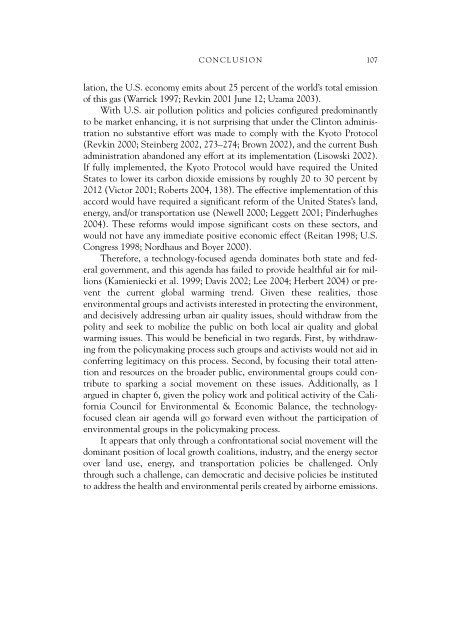GEORGE A. GONZALEZ - fieldi
GEORGE A. GONZALEZ - fieldi
GEORGE A. GONZALEZ - fieldi
You also want an ePaper? Increase the reach of your titles
YUMPU automatically turns print PDFs into web optimized ePapers that Google loves.
CONCLUSION 107lation, the U.S. economy emits about 25 percent of the world’s total emissionof this gas (Warrick 1997; Revkin 2001 June 12; Uzama 2003).With U.S. air pollution politics and policies configured predominantlyto be market enhancing, it is not surprising that under the Clinton administrationno substantive effort was made to comply with the Kyoto Protocol(Revkin 2000; Steinberg 2002, 273–274; Brown 2002), and the current Bushadministration abandoned any effort at its implementation (Lisowski 2002).If fully implemented, the Kyoto Protocol would have required the UnitedStates to lower its carbon dioxide emissions by roughly 20 to 30 percent by2012 (Victor 2001; Roberts 2004, 138). The effective implementation of thisaccord would have required a significant reform of the United States’s land,energy, and/or transportation use (Newell 2000; Leggett 2001; Pinderhughes2004). These reforms would impose significant costs on these sectors, andwould not have any immediate positive economic effect (Reitan 1998; U.S.Congress 1998; Nordhaus and Boyer 2000).Therefore, a technology-focused agenda dominates both state and federalgovernment, and this agenda has failed to provide healthful air for millions(Kamieniecki et al. 1999; Davis 2002; Lee 2004; Herbert 2004) or preventthe current global warming trend. Given these realities, thoseenvironmental groups and activists interested in protecting the environment,and decisively addressing urban air quality issues, should withdraw from thepolity and seek to mobilize the public on both local air quality and globalwarming issues. This would be beneficial in two regards. First, by withdrawingfrom the policymaking process such groups and activists would not aid inconferring legitimacy on this process. Second, by focusing their total attentionand resources on the broader public, environmental groups could contributeto sparking a social movement on these issues. Additionally, as Iargued in chapter 6, given the policy work and political activity of the CaliforniaCouncil for Environmental & Economic Balance, the technologyfocusedclean air agenda will go forward even without the participation ofenvironmental groups in the policymaking process.It appears that only through a confrontational social movement will thedominant position of local growth coalitions, industry, and the energy sectorover land use, energy, and transportation policies be challenged. Onlythrough such a challenge, can democratic and decisive policies be institutedto address the health and environmental perils created by airborne emissions.









